

After Action Report (AAR) for Combative Weapon Solutions Low Light / Home Defense -1 Course
I recently took Combative Weapons Solutions Low Light/ Home Defense 1 course. The class started about 1500 and ran till approximately 2330.


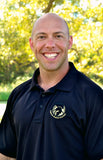

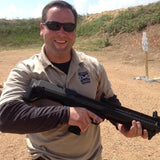

The class started off a little slow. We head a good safety briefing and went over the course outline and what to expect for the day. I felt the briefing was an appropriate length. Not too long, not too short and the instructors covered everything that they needed to.
After the briefing we went to the hot range for a little live fire. It was mainly going over the fundamentals. Grip, stance, sight picture etc. All done from the 3 yard line and firing at a slow pace. Focused on accuracy and nothing else. Next we went over basic trigger control. Concentrating on a slow steady press releasing to reset and then repeating. We also spent a little time reloading the gun from slide lock.
Now I mentioned earlier that the class started off slow. Which it did but I do understand why it was necessary.The instructors wanted to know where everyone stood as far as skill set and how familiar they were with the fundamentals. That is to be expected of any class you will take, and although it was basic, I realize that it needs to be done.
After the first live fire portion (about 2 hours in at this point and 100 or so rounds) we took a short break and met for a lecture portion. This class was primarily a tactics class and not so much of a live shooting class which is nice. Less money spent on ammo and nearly everyone taking this class probably already has the fundamentals down and is relatively familiar with their weapon. This class builds on what you already know and gives you more knowledge on tactics and what to actually do in a given situation. Yes it’s fun to shoot (who doesn’t like to shoot) but tactics are a key component to being prepared and is often overlooked by most shooters.
For the lecture they went over how to clear/ search rooms and talked a great deal about how you use your light. They briefly touched on what you need and what you don’t need in a light as well as talked about the 4 major flashlight holds (FBI, Syringe, Neck Index, Harries) and considerations to take into account for all of them.
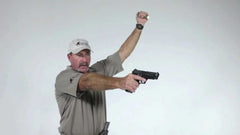

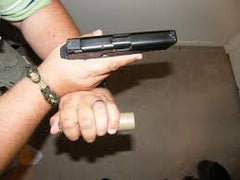

FBI Hold Harries


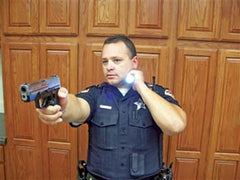

Syringe Neck Index
We then moved into the shoot house and further discussed the techniques mentioned earlier and the instructors demonstrated them as well.
They gave us SIRT training pistols and had us move through the shoot house one at a time, with an instructor behind us to observe, searching the rooms with our lights and gun in hand as we went and practiced the techniques. We did this twice per person.
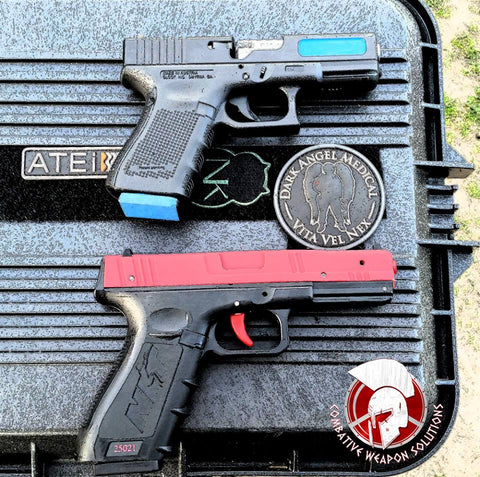

On top is the gun designated for the sim rounds. The bottom is the SIRT training gun
By that time the sun had gone down so we went to the hot range for a short live fire session in the dark. We also went over reloads too. All from 7 yards. After that we went one at a time shooting steel silhouettes from 7, 15, 25, and then 30 yards. This went fast. Less than 20 rounds at the steel. This was simply to get a feel for shooting one handed at night while using a light. If you have never done this or haven’t done it very much it is quite the eye opener as to how much harder it is to be accurate while shooting one handed at night. You really have to watch where your light is aimed. Your shots have a tendency to go where the light is shining. I quickly found out that I need more practice with this!


We broke for a quick lunch and then back to the shoot house where we further practiced searching techniques like we had previously done. Another thing they had us do too was be in the position of the bad guy so we could see what the effects were of being on the receiving end of the light. This really helped understand WHY we we use the techniques that we do.
While they set up the shoot house again we had an instructor working with us doing dry practice on the range practicing and experimenting with the different flashlight holds so we could get an idea of what works for us.
After that it was time for the first scenario with sim rounds. All guns ammo knives etc were put away and everyone was patted down twice. Safety was a top priority as it should be. For the sim portion we had multiple rooms and there ended up being 2-3 shooters (bad guys) on each scenario. The range we were at actually had a building that we used so once inside with the door shut it was completely dark. We had to go through and clear the house like we had practiced but this time there were bad guys shooting back and you were shooting as well.
If you’re not familiar with sim rounds allow me to explain. Basically what they are is paint balls (simulated ammunition) that are fired from an actual firearm. The weapons used were Glock 19s. There is a conversion kit that allows you to shoot the sim rounds through the gun. This is not air soft. This is not paintball. This is a real Glock 19 with Glock 19 mags that is fully functional. You will know when you get hit! If you’re not wearing protective clothing they will draw blood. The benefit of using these rounds for training is that you get to practice using an ACTUAL firearm and also get to go through different scenarios with folks shooting back at you. It’s the closest you can get to an actual incident. You have to act fast and your heart rate increases, adrenaline starts to pump and it adds a little stress. It’s an excellent training tool.
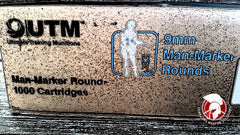



A box of the sim rounds One of the actual rounds
In the second and last scenario of the night it was the same type of setup as the first but this time there was actually an innocent that did not need to be shot. This is where you had to be able to quickly and accurately identify your target.
Overall the class was great. There was some down time waiting for others to go through the course but that is understandable. The only improvement that could be done would be more runs through the shoot house either dry or with the sim rounds. Just to help get used to the new techniques that we learned. Again there’s not a whole lot they could do about this but a few more passes would be excellent. The techniques learned here were simple and basic. They’re easy to remember and with a little practice you can run through them at a fast pace. I like the fact that they did not over complicate things. There was a lot of great information to take in. I took a few notes and I have a pretty good idea of what to practice on my own.
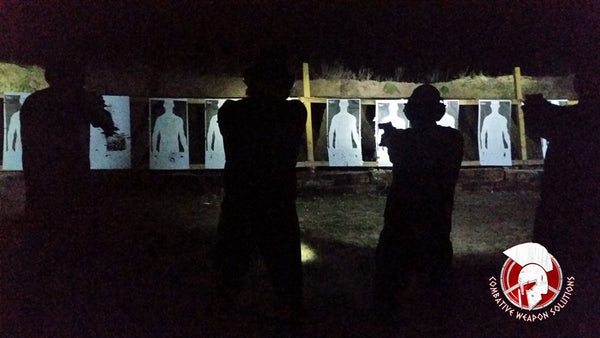

This was an intro to low light. It’s not an all inclusive course by any means. They packed a lot of good information and techniques into a 1 day class. I believe it’s a great option for someone with no formal low light training (such as myself.) Some of the information in the course I had heard and been taught prior to taking this class but there was a great deal of stuff that was new to me. I learned a lot. They also offer a Low Light 2 course which I plan on taking in the future. My guess is that it will build off the fundamentals of low light (that we learned in low light 1) and introduce some more advanced techniques and skills.
That’s all I have for this one. Yall take care, be prepared and be safe.
-Ike Stephens
Please check out my Facebook Page: Big Tex Outdoors
Also be sure to join the largest Concealed Carry group on Facebook: Concealed Carry in the United States



















